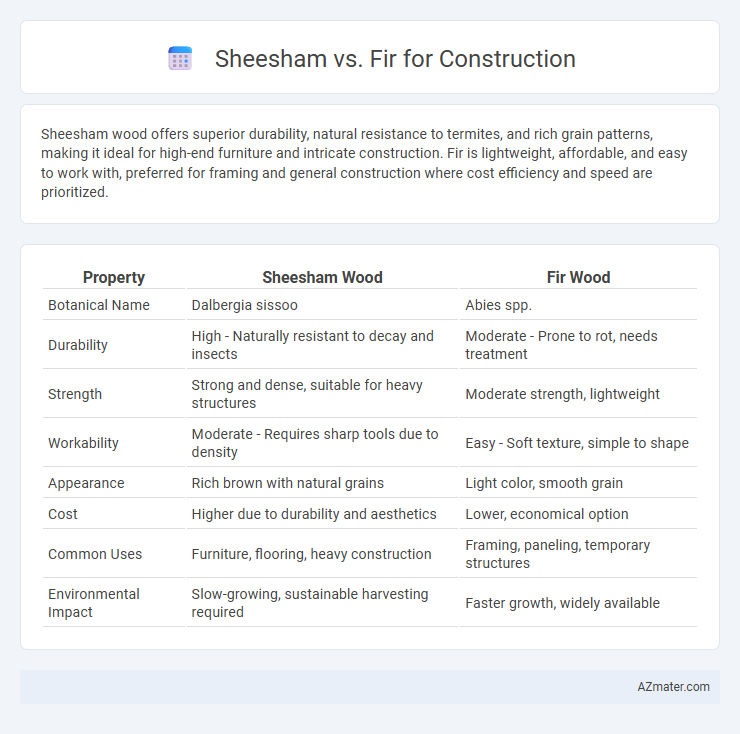Sheesham wood offers superior durability, natural resistance to termites, and rich grain patterns, making it ideal for high-end furniture and intricate construction. Fir is lightweight, affordable, and easy to work with, preferred for framing and general construction where cost efficiency and speed are prioritized.
Table of Comparison
| Property | Sheesham Wood | Fir Wood |
|---|---|---|
| Botanical Name | Dalbergia sissoo | Abies spp. |
| Durability | High - Naturally resistant to decay and insects | Moderate - Prone to rot, needs treatment |
| Strength | Strong and dense, suitable for heavy structures | Moderate strength, lightweight |
| Workability | Moderate - Requires sharp tools due to density | Easy - Soft texture, simple to shape |
| Appearance | Rich brown with natural grains | Light color, smooth grain |
| Cost | Higher due to durability and aesthetics | Lower, economical option |
| Common Uses | Furniture, flooring, heavy construction | Framing, paneling, temporary structures |
| Environmental Impact | Slow-growing, sustainable harvesting required | Faster growth, widely available |
Introduction to Sheesham and Fir Wood
Sheesham wood, also known as Indian Rosewood, is a dense hardwood prized for its durability, rich grain patterns, and resistance to decay, making it ideal for high-quality furniture and construction. Fir wood, derived primarily from Douglas fir and other fir species, is a softwood valued for its strength, straight grain, and ease of workability, commonly used in structural framing and general construction. Both woods offer unique advantages: Sheesham excels in wear resistance and aesthetic appeal, while Fir provides cost-effective strength and flexibility in building applications.
Botanical and Physical Characteristics
Sheesham (Dalbergia sissoo) is a hardwood tree native to the Indian subcontinent, known for its dense, oily grains and high resistance to decay, making it ideal for durable construction. Fir (Abies species), a softwood typically found in temperate regions, features straight grain and moderate strength but is more prone to wear and insect damage. The botanical differences, such as Sheesham's hardwood structure versus Fir's softer, resinous traits, directly influence their physical properties and suitability in construction applications.
Durability and Longevity Comparison
Sheesham wood offers superior durability and longevity compared to Fir, making it highly suitable for heavy construction and furniture that require extended life spans. Its dense grain and natural oils provide excellent resistance to decay, termites, and moisture, surpassing the softer and less dense Fir wood, which is more prone to wear and environmental damage. For projects demanding robust and long-lasting materials, Sheesham's strength and resilience ensure better structural integrity and lower maintenance over time.
Strength and Structural Performance
Sheesham wood exhibits exceptional strength with a density of approximately 830 kg/m3, making it highly durable and resistant to wear, ideal for load-bearing structures and heavy-duty construction. Fir, with a lower density of around 480 kg/m3, offers moderate structural performance, excelling in flexibility and shock resistance but less suited for heavy load applications compared to Sheesham. The superior compressive strength and hardness of Sheesham contribute to its better resistance against deformation and structural failures under high stress.
Resistance to Pests and Decay
Sheesham wood exhibits superior resistance to pests and decay due to its natural oils and dense grain, making it highly durable for construction projects. Fir wood, while commonly used in structural applications, requires chemical treatment to enhance its resistance to insects and rot, as it is more susceptible to decay. Choosing Sheesham over Fir can significantly reduce maintenance costs and extend the lifespan of wooden structures in environments prone to moisture and pest infestation.
Workability and Finishing
Sheesham wood offers superior workability compared to Fir due to its dense grain and natural oils, allowing for smooth cutting, shaping, and sanding without excessive splintering. Fir, being softer and less dense, is easier to machine but may dent or scratch more readily during finishing processes. Sheesham provides a richer, more durable finish with natural luster, whereas Fir requires additional treatments to achieve a comparable aesthetic and protective depth.
Environmental Impact and Sustainability
Sheesham wood, sourced from Dalbergia trees, is renowned for its durability and natural resistance to pests, offering a sustainable option when harvested from responsibly managed forests. Fir, typically sourced from fast-growing conifers, tends to have a lower carbon footprint due to quicker regeneration and shorter growth cycles, making it a favorable choice for eco-friendly construction projects. Both woods should be certified by organizations like FSC to ensure environmentally responsible harvesting practices that support long-term forest health and biodiversity.
Cost and Availability
Sheesham wood is generally more expensive than fir due to its durability and rich grain, making it preferred for high-end furniture and interior construction. Fir is more affordable and widely available, commonly used for structural framing and general construction projects. Availability of Sheesham can be limited outside its native regions in India, whereas fir is abundant and sourced globally, impacting project timelines and budgeting.
Best Applications in Construction
Sheesham wood, known for its dense grain and natural resistance to rot and pests, is ideal for heavy-use construction elements like flooring, furniture, and cabinetry where durability and aesthetic appeal are paramount. Fir wood, favored for its straight grain and softness, excels in structural framing, paneling, and interior joinery due to its flexibility and ease of work. For projects requiring robust, long-lasting materials, Sheesham is superior, while Fir is best suited for cost-effective framing and lightweight structural components.
Final Verdict: Choosing Between Sheesham and Fir
Sheesham wood offers exceptional durability, rich grain patterns, and natural resistance to decay, making it ideal for premium furniture and intricate construction details. Fir wood is lighter, more affordable, and easier to work with, suited for structural framing and general construction purposes where strength and cost-efficiency are priorities. For final verdict, choose Sheesham for luxury, longevity, and aesthetics, while Fir is best for budget-friendly, lightweight, and practical construction projects.

Infographic: Sheesham vs Fir for Construction
 azmater.com
azmater.com